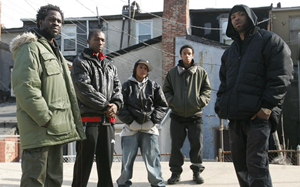Changing Attitudes: Ethnicity
In the second part of the series on changing to attitudes we take a look at ethnicity in popular culture. Has literature by minorities been given more recognition over the years? What kinds of roles are black and Asian men playing, are they positive or negative? How many ethnic people are walking the catwalks of Paris?
Literature

The pre-Second World War writings of Cyril Lionel Robert James and George Padmore were instrumental in the push for the independence of the West Indies and the colonised nations of Africa. C.L.R. James arrived in 1932, and in 1937 had ‘Minty Alley’ published, becoming the first novel to be published by a black Caribbean author in the UK. The post-war migration of the West Indians were disillusioned by the racial prejudice they suffered in Britain and included this in their work, from Sam Selvon’s ‘The Lonely Londoners’ (1956), to George Lamming’s ‘The Emigrants’ (1954) and E.R. Braithwaite’s ‘To Sir With Love’ (1959). The 1970’s brought even more writers from the Caribbean who wrote about their disillusionment, frustration, the myths and stereotypes they had to overcome including John Agard, Beryl Gilroy and Grace Nicols. Many great pieces of work on oppression also came from other former British colonies, such as India. And at the turn of the millennium, White Teeth by Zadie Smith, was widely hailed as the first black British novel of the new era. Diane Abbott MP notes that ‘recently, the literary establishment has been willing to acknowledge the contribution of black and ethnic minority writers like Ben Okri, Alice Walker, Gabriel Garcia Marquez, Arundathi Roy, Salman Rushdie and Nobel prize winning Toni Morrison.’ Not only has this change given a voice to ethnic minority groups, but the increase in black characters has served as positive images groups can identify and relate with too.
Although terms such as post-colonial literature or black British literature are often considered problematic. Grouping texts together as black texts, women’s writing, postcolonial or gay writing, are acts in history showing that they are now significant or an attempt to root them in literature. But for some the vast differences in these texts all being put in the same category is counterproductive.

There are some earlier examples of ethnic minority characters in literature by Daniel Dafoe and Shakespeare. Titus Andronicus is a tragedy by William Shakespeare featuring a black character – ‘Aaron the Moor‘, a diabolical mastermind behind the plot to destroy the Andronicus family. Shakespeare uses some 16th century stereotypes, presenting Aaron’s blackness as synonymous with evil and showing him as overly sexual shall we say; a trait often associated with black characters in Elizabethan literature. Aaron says:
Let fools do good, and fair men call for grace.
Aaron will have his soul black like his face. (3.1.4)
Othello is probably the most well-known black character however. Othello was a Moorish general in the Venetian army and all characters except Iago looked passed his colour and perceived him as a great and accomplished general.
Film/TV
Many films made in the inter-war period embraced the notion of Empire as a civilising force. We see this in Edgar Wallace’s ‘Sanders of the River’ (1935). A story of a British District Officer restoring peace amongst the child-like natives, which ultimately portrays ethnic groups as uncivilised but mouldable. Following this period, in response to the increase of immigration from outside Europe and the re-emergence of Neo-Fascist politics, was an initial tendency to ignore racial issues, as in 1960 British film ‘Saturday Night and Sunday Morning’. The racial stereotyping of the Seaton family in their encounter with a black soldier found in Sillitoe’s book does not appear in the film version, neither does the Indian lodger/lover, Chumley, of Arthur’s mother-in-law. But there were exceptions, including the movie ‘Flame in the Streets’ in 1961, which told the story of racial tensions during Bonfire Night in the West Indian community of early 1960s Britain. Trades union leader (Mills) fights for the rights of a black worker but struggles with the news that his own daughter is planning to marry a West Indian.

There has been a big increase in the amount of films dealing with racial issues but when it comes to film and TV there are still many other issue that remain. David Harewood, star of Blood Diamond was made an MBE, yet in an interview he spoke on feeling ‘slightly conflicted’ about winning the award: ‘Although it is a great honour, I still feel there is a hell of a lot of work to be done here… Looking at the TV schedules over Christmas, I did not see many black faces in dramas.’ While a quarter of London’s workers are ethnic minority, only 7 per cent of those who work in its film industry are; a figure that was 3 per cent 30 years ago. Broadcasting union Bectu says it will take 120 years at the current rate for it to reflect the demographics of the London workforce.
Possibly the most persistent and detrimental problem is the characters that black actors are often chosen for. The 1940’s through to the 1970’s was a period of crude stereotypes, Scottish, Irish, Welsh and English along with portrayals of ‘funny foreigners,’ from Indians with amusing mispronunciations to onion-toting Frenchmen. When black actors featured in dramas they often and still do played negative stereotypes such as gangsters.
Director, Spike Lee referred to Tyler Perry’s TV shows featuring black comedic characters as ‘coonery buffoonery’. Lee also recently took to his Twitter account to slam the film Djanjo Unchained. Spike Lee wrote: American Slavery Was Not A Sergio Leone Spaghetti Western. It Was A Holocaust. My Ancestors Are Slaves. Stolen From Africa. I Will Honor Them.

One angry commenter online speaks on the effect of a reality show starring rapper Shawty Lo, his 11 children, their 10 mothers, and his latest 19-year-old girlfriend, and the power of the media in controlling images and shaping public opinion.
“Here’s a news flash: We look to the media for information! If the information that people who have very limited (or no) exposure to blacks is getting tells them that we are all Neanderthals, then that is how they are going to view us, and when/if they do encounter us, they will treat us accordingly… Let’s face it — most people are not evolved enough to think critically and sceptically about what they are being force-fed in the media”
There has been a noted increase in the number of films on racial and ethnic issues. But still there is a lack of shows and films produced and directed by ethnic minority writers, this is coupled with poor representation and one-dimensional characters black actors regularly play – black men especially are often presented as dangerous, gun-toting, violent and promiscuous.
The literary establishment has made a conscious effort to give recognition to minority writers. This is great news but TV arguably has a long way to go before ethnic minority actors are well represented and playing positive roles.
By Natasha Holder



